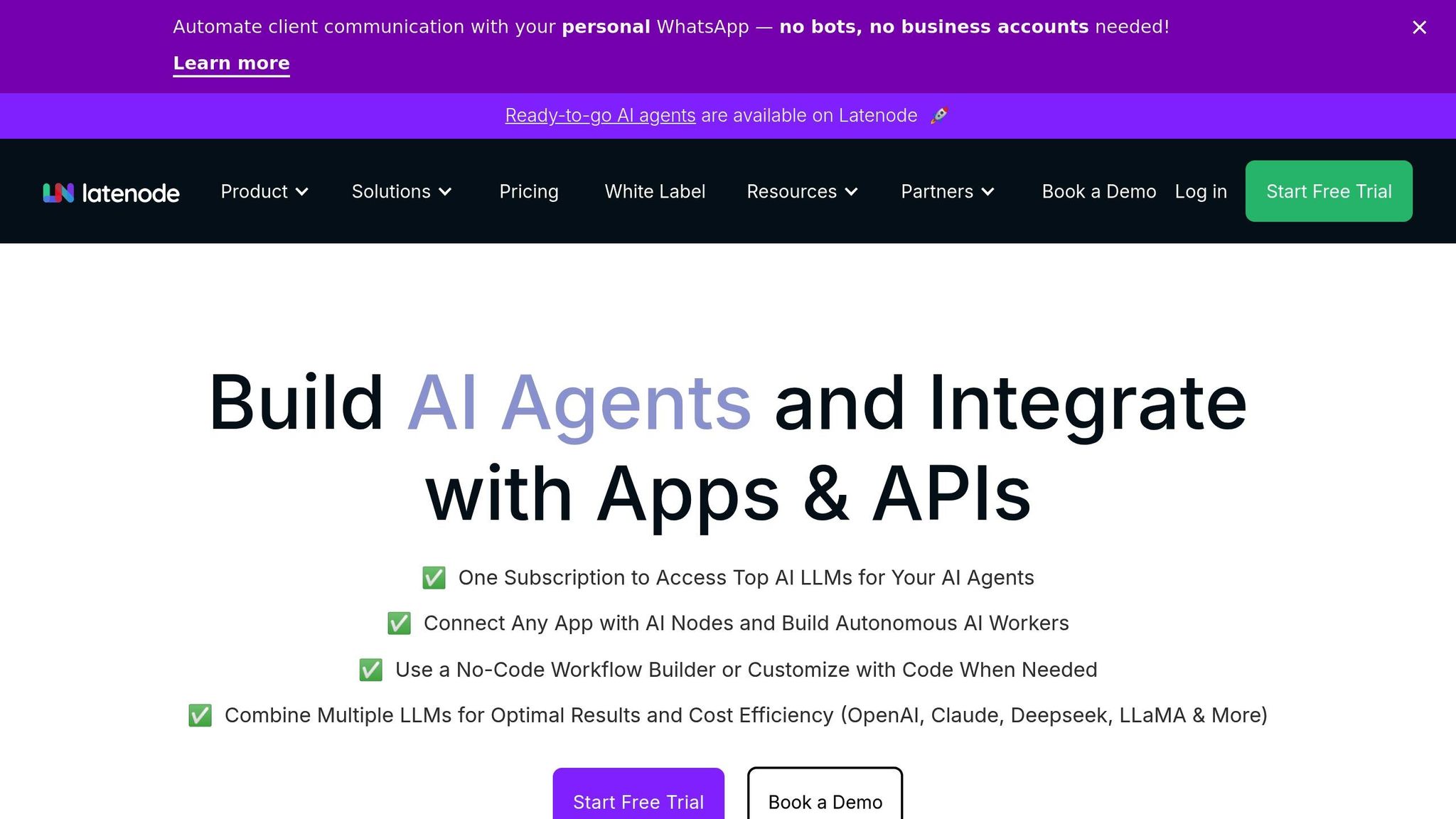


AI-powered automation is reshaping how businesses operate, with adoption surging from 33% in 2023 to 71% in 2024. This shift has delivered measurable results: cutting operational costs by 20–30%, increasing processing speeds by 25%, and reducing compliance expenses by 30%. Platforms like Latenode are leading the way, offering a flexible, low-cost solution for automating complex workflows without the rigidity of older systems.
With its low-code interface, Latenode integrates over 200 AI models and connects to 300+ apps, making it easier to streamline tasks like payroll, invoice management, and procurement. Its execution-based pricing starts at just $5/month, ensuring affordability while reducing hidden costs often associated with older platforms. Businesses can also self-host to meet compliance needs, a critical factor in today’s regulatory landscape.
Here’s why this matters: traditional automation systems often struggle with variability, leading to higher maintenance costs and inefficiencies. Latenode’s dynamic workflows reduce manual intervention, handle unstructured data, and consolidate processes, saving time and money. Whether you’re scaling operations or tackling repetitive tasks, AI-driven platforms like Latenode offer a practical way to stay competitive while keeping expenses in check.

Latenode is an automation platform designed to streamline operations and cut costs through its AI-driven architecture. By combining a visual workflow builder with the ability to integrate custom code, it allows businesses to create automations with minimal overhead compared to traditional enterprise solutions.
Latenode employs a straightforward, execution-based pricing model that ensures transparency. The Micro plan starts at just $5 per month, offering 2,000 credits, while the Grow plan provides 50,000 credits for $47 per month, including unlimited workflows and connections. Additionally, Latenode's built-in database functionality eliminates the need for external database services, which further reduces costs.
This focus on affordability is paired with advanced AI integration capabilities, making it a budget-friendly yet powerful automation solution.
Latenode simplifies the integration of various AI models, including OpenAI, Claude, Gemini, and custom-built models. Its structured prompt management system ensures businesses can incorporate AI without needing extensive machine learning expertise. This makes it easier to leverage advanced AI tools for a wide range of applications.
Built to grow alongside your business, Latenode’s architecture supports both horizontal and vertical scaling. This flexibility reduces infrastructure costs while ensuring resources can adjust to meet demand. For businesses seeking complete control, the platform also offers a self-hosting option.
With support for over 300 app integrations, Latenode enables companies to expand their automation capabilities incrementally. As needs evolve, additional services and data sources can be seamlessly connected to the platform.
Latenode empowers both technical and non-technical users with its combination of a visual workflow builder and custom code functionality. Developers can access over 1 million NPM packages, allowing them to integrate specialized libraries and create tailored functions directly within workflows. This reduces manual tasks and operational expenses.
The platform also includes advanced features like headless browser automation and conditional branching, enabling workflows to adapt dynamically in real time. These tools make it easier for businesses to craft flexible, efficient processes that meet their unique requirements.
Traditional automation platforms, while effective in some areas, often fall short when it comes to flexibility and ease of integration. These systems tend to be rigid and require significant technical know-how, especially when businesses aim to incorporate AI models into their workflows.
Traditional platforms can reduce labor costs by 20–40% and improve processing speeds by 40–60%. However, these benefits come at a price. Maintenance demands are high, and scaling up often leads to steep expenses. For example, a retail chain found itself managing 17 separate workflows just to handle slight variations in inventory. This multiplied both development and upkeep costs significantly.
On top of that, many traditional platforms charge extra for AI integrations or require extensive development to connect with external AI services. This fragmented pricing model can make it hard to predict or control expenses, adding another layer of complexity to cost management.
Integrating AI models with traditional platforms often involves juggling multiple API keys and managing relationships with various vendors. This process can be time-consuming and requires ongoing maintenance. Most platforms don’t provide easy access to a wide range of AI models, leaving users to create custom connections for each service. This not only delays implementation but also makes it harder to experiment with or switch between AI solutions.
Traditional platforms perform well with repetitive, rule-based tasks that have clear inputs and outputs. However, they struggle when variability enters the picture. Their linear workflows rely on binary decision-making, which can become a bottleneck in complex, real-world scenarios. For instance, one healthcare provider saw a 65% drop in data entry errors using traditional automation. Yet, issues with handling exceptions increased by 30%, as these systems couldn’t adapt to unexpected changes without manual intervention. Any workflow adjustment required reprogramming, which further drove up operational costs.
These platforms are designed for structured data and repetitive tasks, making them less effective when business needs evolve. Their rigid workflows mean that even minor deviations from the norm often require manual adjustments or custom development. For example, a manufacturing company reduced invoice processing time from 15 minutes to 3 minutes using robotic process automation. However, any non-standard invoice format had to be handled manually, leading to delays during busy periods.
When comparing modern AI-powered automation platforms to traditional systems, key differences emerge across four critical areas that directly influence operational efficiency and costs.
| Feature | Latenode | Traditional Automation Platforms |
|---|---|---|
| Cost Efficiency | Transparent pricing with no hidden task limits, access to over 200 AI models, and self-hosting options to reduce long-term expenses. | Lower initial costs, but rigid architecture often leads to higher long-term maintenance and scalability expenses. |
| AI Model Integration | Built-in support for over 200 AI models, including OpenAI, Claude, and Gemini, with structured prompt management for seamless automation. | Typically lacks native AI integration, requiring manual development to incorporate AI capabilities. |
| Scalability | Adaptive workflows that optimize themselves, handling dynamic environments with autonomous decision-making. | Performs well with repetitive tasks but struggles with variability; fixed workflows can create bottlenecks as complexity grows. |
| Workflow Customization | Combines visual and code-based flexibility, featuring a built-in database and headless browser automation to handle exceptions automatically. | Often relies on rigid, pre-programmed workflows, requiring reprogramming for even small changes and manual intervention for non-standard inputs. |
The table underscores the differences in flexibility, scalability, and maintenance between AI-native platforms like Latenode and traditional systems.
One of the standout benefits of Latenode is its ability to reduce execution and maintenance costs. Traditional systems often rely on fixed instructions, necessitating frequent manual updates to accommodate changes. This drives up maintenance expenses over time. In contrast, Latenode leverages AI to create workflows that adapt and improve autonomously, making it particularly effective in dynamic industries such as e-commerce and healthcare.
Another area where Latenode excels is handling unstructured data and variable inputs. Its ability to process natural language and manage edge cases autonomously significantly reduces the need for manual intervention, streamlining operations and lowering costs.
While traditional platforms might appeal to businesses with stable and predictable processes due to their lower upfront costs, their rigidity can become a liability. Even minor deviations often require multiple workflows, increasing development and maintenance expenses. On the other hand, Latenode's adaptable workflows consolidate processes, adjusting contextually to reduce both development time and ongoing costs.
For businesses weighing their options, the decision often depends on growth plans and operational needs. Companies with steady, repetitive tasks may find traditional platforms sufficient. However, those operating in dynamic environments or expecting significant growth will likely benefit from Latenode's AI-driven flexibility and cost transparency.
The evidence is clear: AI-powered automation is reshaping how U.S. businesses manage costs, delivering tangible savings through reduced labor expenses, fewer errors, and smarter resource allocation. These benefits directly impact a company’s bottom line, making automation a strategic priority.
The growing reliance on AI-native platforms marks a major shift in automation strategies. With 71% of organizations using generative AI by 2024, and nearly half reporting noticeable productivity improvements, the trend highlights measurable success. AI models now achieve up to 99.99% accuracy in critical financial tasks like payroll and invoice processing, virtually eliminating the costly mistakes and rework that traditional systems often require.
Latenode stands out as a prime example of this new wave of automation platforms, offering U.S. businesses a practical way to achieve these cost savings. Its transparent pricing eliminates hidden fees that can drive up costs, while access to over 200 AI models and 300+ integrations ensures the flexibility needed to handle complex workflows without the need for expensive custom development. Additionally, its self-hosting option addresses critical compliance concerns, granting businesses full control over their data - an essential factor in today’s regulatory landscape. These features make Latenode a strong choice for businesses aiming to scale efficiently in dynamic environments.
For growing companies, traditional systems may appear cost-effective at first but often come with rigid architectures that create bottlenecks and drive up long-term expenses. In contrast, Latenode’s dynamic workflows and integrated AI capabilities allow businesses to scale without increasing maintenance costs or requiring extensive manual oversight.
What sets Latenode apart is its ability to adapt to unforeseen challenges - handling variable inputs, unstructured data, and edge cases without the need for costly reprogramming. This flexibility leads to direct cost savings, enabling businesses to manage fewer, more versatile workflows instead of juggling multiple rigid processes. This adaptability aligns with the broader trend of AI-driven workflows addressing the evolving challenges of modern business operations.
Latenode's pricing structure focuses on execution time instead of charging per task or operation. This model can lead to savings of up to 90% compared to traditional platforms that rely on per-task pricing.
With no hidden restrictions and flexible scalability, Latenode allows businesses to pay solely for the resources they actually use. This makes it an excellent choice for teams aiming to build efficient and budget-friendly automation workflows.
Using AI models for automation brings a host of advantages, such as improved precision, streamlined processes, and reduced costs by cutting down on manual errors and refining workflows. These models excel at handling intricate tasks swiftly, making them a game-changer for businesses looking to expand their operations efficiently.
Latenode simplifies the integration of AI models by offering built-in support for over 200 AI models, including popular options like OpenAI, Claude, and Gemini. Its user-friendly platform blends visual workflow tools with the flexibility of coding, enabling users to automate tasks, organize structured data with an integrated database, and even execute web actions through headless browser automation. With Latenode, businesses can tap into AI’s capabilities in a scalable and cost-conscious way, tailored for advanced automation requirements.
Latenode supports businesses in adhering to compliance and regulatory standards by emphasizing data security, control, and adaptability. With self-hosting options, users retain full authority over their data, making it easier to align with stringent regulations such as GDPR and other industry-specific requirements.
Moreover, Latenode's integrated compliance tools and strong security measures ensure confidence for businesses operating in tightly regulated sectors. This positions it as a dependable and scalable automation solution for teams navigating complex regulatory landscapes.



